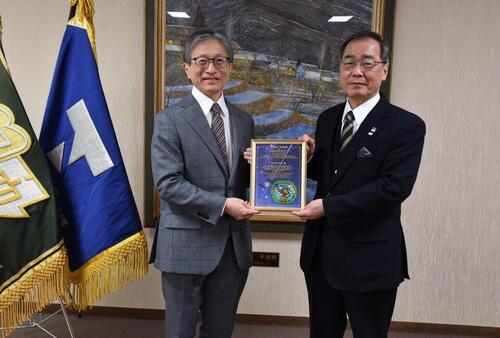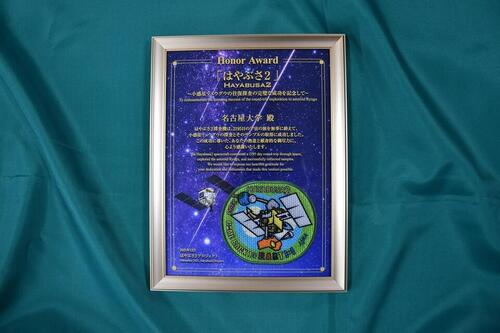Nagoya University has received a letter of appreciation from the Japan Aerospace Exploration Agency (JAXA) Hayabusa2 Project for the University's significant contributions to the advancement of Japan's space science and exploration. This was primarily achieved through a collaboration agreement with JAXA. At the University, Professor Sei-ichiro Watanabe of the Graduate School of Environmental Studies (who has been serving as the Hayabusa2 Project Scientist), other faculty members, and students have all made important contributions to this project in various ways.
The Hayabusa2 spacecraft was launched from the Tanegashima Space Center in Japan in December 2014 to explore the asteroid Ryugu, maximum 300 million kilometers away from the Earth. Completing approximately six years of space exploration, Hayabusa2 brought capsules back down to the Earth in December 2020. Hayabusa2's operations at Ryugu were all successful, making it possible to bring a much more substantial amount of samples than planned back to the Earth. A number of papers on the exploration have been published in science journals. This success is the result of the efforts of people at universities and research institutions in Japan and overseas, as well as at companies that developed the space probes and equipment.
 Prof. Watanabe (left) and Nagoya University President Matsuo (right)
Prof. Watanabe (left) and Nagoya University President Matsuo (right)
Comment by the Hayabusa2 Project Scientist, Sei-ichiro Watanabe (Professor at the Graduate School of Environmental Studies, Nagoya University)
We have been analyzing the samples brought by Hayabusa2 and so we are submitting some papers on the primary research results to journals. Our spectral analysis of the samples from the asteroid Ryugu has shown that they are similar to CI chondrite, the most primitive carbonaceous chondrite meteorite. We expect that this finding will lead to unveiling the mystery behind the formation of the Solar System.
I am deeply grateful to Nagoya University for providing me with an environment where I can devote myself to Hayabusa2 research.
 Letter of Appreciation from the JAXA Hayabusa2 Project
Letter of Appreciation from the JAXA Hayabusa2 Project
JAXA Hayabusa2 Project Website:
